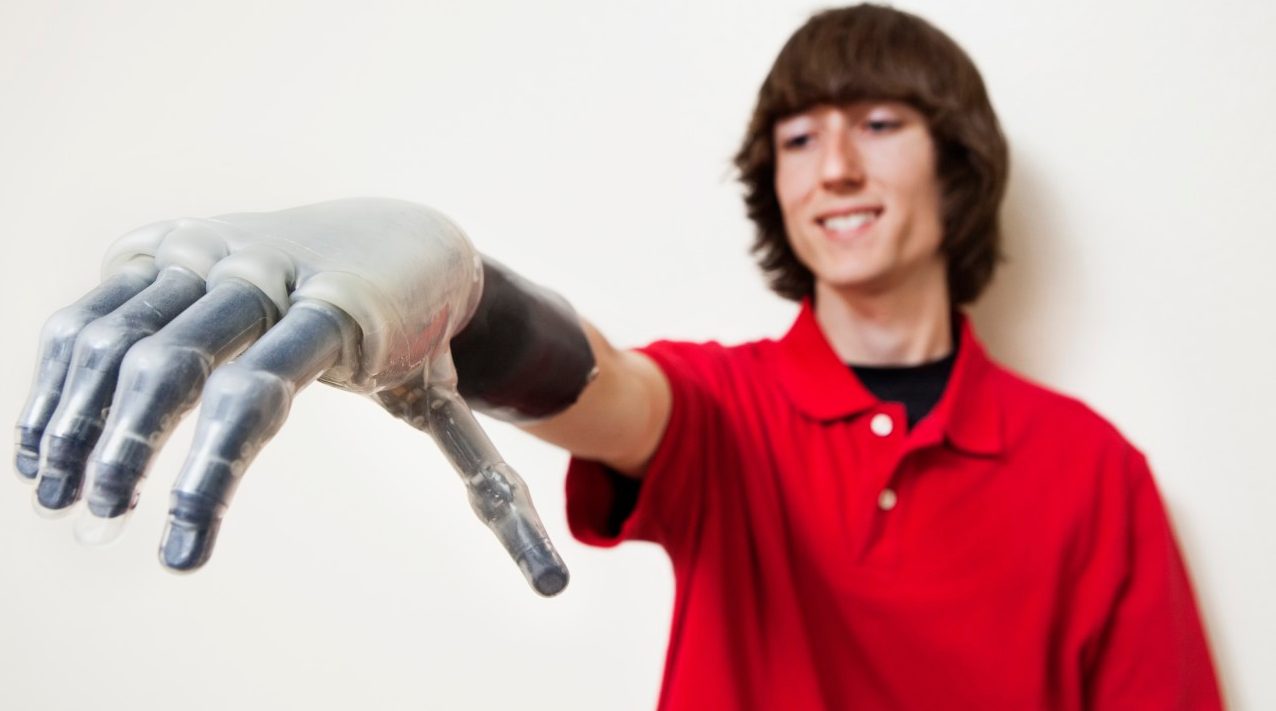Modern Prosthetic Hands Are More Advanced

New prosthetic hands look and move much like the real thing, and many amputees have more mobility than ever before. They may soon have sense of touch, too.
Nearly 2 million Americans, including U.S. military veterans, are living with the loss of a limb. But with modern prosthetics, many amputees have more mobility than ever before. Specialized lower limb prosthetics even allow some athletes who have lost legs to pursue running.
The field of prosthetics is quickly moving into even more life-like bionic territory. Researchers have created high-tech artificial hands that move and grip much like the biological kind. Scientists are also working on ways to further merge biology and technology — including making prosthetic devices that feel.
YOU MIGHT ALSO LIKE: Caring for People with War-Related Amputations
The Defense Advanced Research Projects Agency (DARPA), part of the U.S. Department of Defense, funded the creation of one of the most advanced bionic limbs ever. In fact, it looks and works like something out of a science fiction movie. It’s called the LUKE/DEKA advanced prosthetic arm, in honor of the “Star Wars” character who received a prosthetic after losing his hand fighting Darth Vader.
Developed by scientists at the DEKA Research and Development Corporation, the battery-powered prosthetic is the same shape and weight as an adult arm, thanks to technological breakthroughs allowing miniaturization of parts for motors, computer controls, and sensors. The LUKE/DEKA arm was the first prosthetic arm capable of performing multiple, simultaneous movements.
Small electrodes placed near muscles where the prosthesis is attached detect electrical signals when the muscles contract. The electrical signals are sent to a computer processor in the prosthesis, which translates them to specific movements. The result is near-natural control of the artificial arm and jointed fingers, allowing amputees fitted with the bionic device to handle objects as delicate as grapes and eggs. The prosthetic can even manipulate power tools, such as a hand drill.
Originally targeted by DARPA for veterans who had upper limb amputations, the Luke Skywalker-inspired arm is now approved by the Food and Drug Administration for other amputees.
A programmable prosthetic hand called the i-limb quantum is another highly advanced artificial limb helping to change lives. Dozens of programmed grip patterns allow people fitted with the hand to complete a range of activities requiring different hand strengths — from eating with a fork and shaking hands to grasping a steering wheel and using only one finger to tap a remote control or ring a doorbell.
Produced by the bionics company Össur Touch Solutions, the i-limb quantum looks much like a robotic version of a human hand, with fingers that bend. It’s externally powered by a battery and movements are controlled, like the LUKE/DEKA arm, by myoelectric signals — meaning the prosthetic uses muscle signals from the wearer’s remaining limb muscles.
Bluetooth technology also helps control the bionic hand via a smartphone or desktop app and lets those wearing it use more features than those controlled by muscle triggers alone. For example, a tap of a button on the app screen can offer up to 24 additional hand grips.
The i-limb quantum is expensive. Prices can range from $45,000 to more than $70,000. But users report feeling empowered.
“I walk into a room and I used to try to blend in — I don't need to blend in now," said Lizbeth Uzcategui, the first U.S. woman to receive the technologically advanced i-limb quantum. She was born without a right arm below her elbow. "I cannot wait to learn about all the other things I'm going to be capable of doing."
As remarkable as these advanced bionic limbs are, they don’t provide users with a sense of touch. But scientists are working to change that, creating upper limb prosthetics that will feel hot and cold and other sensations.
A team of engineers and researchers at Washington University in St. Louis, headed by Daniel Moran, PhD, helped pioneer a device designed to allow upper limb amputees to feel through their artificial limb via sensory signals sent from a prosthetic hand to nerves in the upper arm and forearm.
A team at the University of Pittsburgh is also working on prosthetic devices with the ability to feel and transmit sensations to the spine.
Researchers are also trying to design limbs that not only move and react like natural limbs but also look like real, biological body parts. To that end, a team of European electronic and mechanical engineers and scientists from Valencia Polytechnic University and Czech Technical University hope to develop prosthetic hands based precisely on actual hand anatomy, using 3D-printed hand phalanges (the 14 bones that are found in the fingers of each hand).
The goal is to create highly personalized prosthetic fingers that will provide increased freedom of movement for the person wearing the prosthetic. In addition to the individualized fingers, the researchers are testing surface electromyogram (EMG) sensors that can allow a user to control a prosthetic hand’s ability to grasp and let go with more realistic and controlled movements.
Updated:
December 15, 2022
Reviewed By:
Janet O’Dell, RN